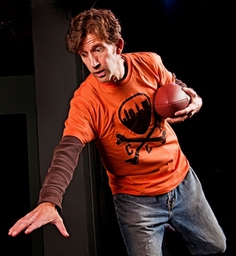The Kardiac Kid
“The Kardiac Kid is a poignant love letter to the Browns, to the city and to those who suffer to this day in our orange and brown knit caps” ~Christine Howey, RaveandPan
“Even if you aren’t a football fan, Schmiedl’s fervor proves infectious.” ~ Jewish News
 Connections, Orange, Brown & Beyond:
Connections, Orange, Brown & Beyond:
A Personal Message from Eric Schmiedl
In the winter of 1977 I went on a sixth grade after-school trip to the Kent State indoor ice skating rink. We rode a school bus out to the university, piled off into the rink, rented our ice skates, and spent two-hours making wobbly circles in the ice while the songs of ELO and Leo Sayer blared from speakers high above us.
I sped around with my orange and brown knitted Browns cap on my head. The big pom-pom on top jiggled back and forth. It was a glorious time, topped off with a plate of french fries and a Pepsi from the snack bar.
On the bus ride home I quickly realized that I did not have my Browns cap on my head anymore. I checked the pockets of my coat. I checked the bus seat. Nothing. Then I remembered that I had taken off the cap when I stopped skating because I was hot. I had forgotten about it during the mad rush to the snack bar, and now it was sitting somewhere back at the rink while I was bustling along Route 43, moving farther away from my cap with each passing house and tree. It was absolutely gone. Everybody else on the bus fell asleep, but I sat peering into the darkness – wide-eyed.
seat. Nothing. Then I remembered that I had taken off the cap when I stopped skating because I was hot. I had forgotten about it during the mad rush to the snack bar, and now it was sitting somewhere back at the rink while I was bustling along Route 43, moving farther away from my cap with each passing house and tree. It was absolutely gone. Everybody else on the bus fell asleep, but I sat peering into the darkness – wide-eyed.
When she picked me up at school my mother asked if I had a good time, and  I immediately burst into sobs. The intensity of the emotion surprised us both. And to be honest I had not really thought very much about that old cap. It was just something I wore. But now that it was gone it was different. It was important. It was me
I immediately burst into sobs. The intensity of the emotion surprised us both. And to be honest I had not really thought very much about that old cap. It was just something I wore. But now that it was gone it was different. It was important. It was me
Funny how these things hit you. I had a similar experience working on the premier production of The Kardiac Kid. I am a native Clevelander. So, I knew about the Kardiac Kids. Like thousands of others I cheered for the team with my mother in front of our own color RCA. But when I started marking the season for the production – game by game – and following the various stories found in the play – of the girl Abigail and the Catholic priest Fr. Kerry and the die maker Eddie Schorger – I realized how much of my own identity was connected to this team and this era and this city. Much to my surprise I had forgotten that. What’s more, I learned that I wasn’t the only one. After performances at Cleveland Public Theatre last year I exchanged dozens of stories with audience members about our shared memories of 1980 in Cleveland. Of Brian Sipe and Reggie Rucker. Of Randall Park Mall. Of The Pewter Mug. I was recently someplace when someone asked me what I was working on next. I said I’m remounting a play about the Kardiac Kids.The man’s eyes suddenly lit up. Now that was a team, he said.
It certainly was a team. But it’s more than just a football team or a game or a cap even because these things end or get lost. It’s about our connection to these things because that connection is eternal. And sometimes all we need is a small spark to help us see the connection – to see who we were and who we are and who we can become.


 Connections, Orange, Brown & Beyond:
Connections, Orange, Brown & Beyond: